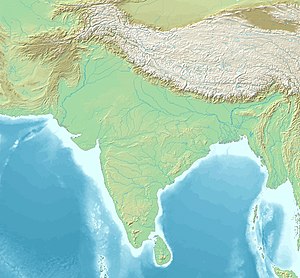Kakrak Valley (Bamyan)
Appearance
(Redirected from Kakrak Valley, Bamyan Province)
Kakrak Valley
درهٔ ککرک | |
|---|---|
| Coordinates: 34°48′36″N 67°51′09″E / 34.809877°N 67.852553°E | |
| Country | |
| Province | Bamyan Province |
| Population | |
| • Ethnicities | Hazara people |
| Time zone | + 4.30 |
Karkak Valley (Dari: درهٔ ککرک) is a valley in central Afghanistan, located in Bamyan province, 120 km west of Kabul province.
The famous Buddhist mural named "The Hunter King" (7-8th centuries CE) shows a typically local royal figure seated on a throne, his bow and arrows on the side. He wears a triple-crescent crown which has been compared to the triple-crescent crowns on the coinage found in northeastern Afghanistan in the area of Zabulistan, such as a coin found in Ghazni.[1] Late 7th to early 8th century CE.[2][3] Other authors have attributed the triple-crescent crown to Hephthalite influence.[4] The painting may be an allegory of a King abandoning violence, particularly the hunting of animals, and converting to Buddhism.[5]
Murals from Kakrak
[edit]-
The triple-crescent crown in the "Hunter King" mural from Kakrak (7th-8th century CE) has been compared to the triple-crown in some of the coinage of Afghanistan.[1][3] Wall paintings from the 7th-8th century, Kabul Museum.[4]
-
Seated Buddha, Kakrak
-
Coupole, Kakrak. Bamiyan. Musée national des arts asiatiques Guimet.
See also
[edit]Wikimedia Commons has media related to Kakrak.
References
[edit]- ^ a b Hackin, Joseph (1936). L'Œuvre de la Délégation Archéologique Française en Afghanistan (1922-1932) : vol.1. p. 49.
- ^ Göbl 1967, 254 ; Vondrovec tyre 254
- ^ a b Alram, Michael; Filigenzi, Anna; Kinberger, Michaela; Nell, Daniel; Pfisterer, Matthias; Vondrovec, Klaus. "The Countenance of the other (The Coins of the Huns and Western Turks in Central Asia and India) 2012-2013 exhibit: 14. KABULISTAN AND BACTRIA AT THE TIME OF "KHORASAN TEGIN SHAH"". Pro.geo.univie.ac.at. Kunsthistorisches Museum Vienna. Retrieved July 16, 2017.
- ^ a b Compareti, Matteo (2008). "The Painting of the "Hunter-King" at Kakrak: Royal Figure or Divine Being?". Studio Editoriale Gordini: 133.
- ^ "According to Jäger's interpretation, the so-called "Hunter-King" was a symbolic representation of a royal person who converted to Buddhism and abandoned hunting and violence in general." inCompareti, Matteo (2008). "The Painting of the "Hunter-King" at Kakrak: Royal Figure or Divine Being?". Studio Editoriale Gordini: 133.





![The triple-crescent crown in the "Hunter King" mural from Kakrak (7th-8th century CE) has been compared to the triple-crown in some of the coinage of Afghanistan.[1][3] Wall paintings from the 7th-8th century, Kabul Museum.[4]](http://upload.wikimedia.org/wikipedia/commons/thumb/e/e7/Kakrak_Hunter_King.jpg/170px-Kakrak_Hunter_King.jpg)


